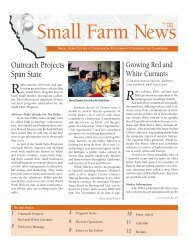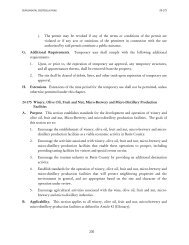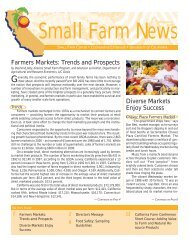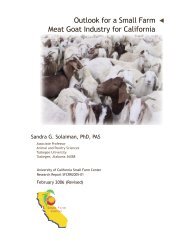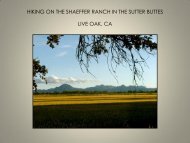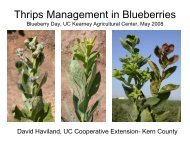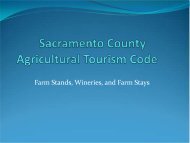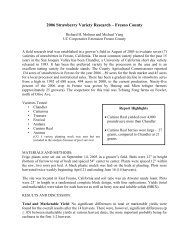A Market-Driven Enterprise Screening Guide - University of ...
A Market-Driven Enterprise Screening Guide - University of ...
A Market-Driven Enterprise Screening Guide - University of ...
Create successful ePaper yourself
Turn your PDF publications into a flip-book with our unique Google optimized e-Paper software.
characteristics:• They appeal to an adequately sized target market.• They have an extended production and marketingseason.• They are complementary to the farm operation.• They are difficult to grow (steep learning curve).• They are expensive to start producing (high initialcapital investment).• They hold potential for value-adding activities.In addition, growers must assess the quality andavailability <strong>of</strong> information related to:• <strong>Market</strong> data, research and analysis• On-farm research and development• Trends (demographic, economic, health, etc.)• Crop adaptation to a specific location• Pest and disease problems• Supporting infrastructure and facilities• Laws & regulations (i.e. permits and licenserequirements)Although these factors are not equally important forevery new or alternative crop, growers must addressall <strong>of</strong> them to make a well-informed choice. Once thealternative crops are specified, growers must assess thecrops’ potential for success given both their availableresources and the risk factors identified.How to Use this <strong>Guide</strong>The market-driven enterprise screening guide canhelp you assess the potential <strong>of</strong> new or specialtyenterprises. Special emphasis is placed on marketingand market factors since these are typically the mostcritical in determining the attractiveness <strong>of</strong> newor specialty crop alternatives. The guide consists<strong>of</strong> a series <strong>of</strong> questions to guide your thinkingin evaluating a new enterprise. A new enterprisemight be a new crop, a different way <strong>of</strong> producingor marketing an existing crop, or a new use for anexisting crop. The screening guide first frames thegeneral descriptive situation, next poses a series <strong>of</strong>questions (the screening worksheet) that asks youto rate the particular enterprise, and finishes with asuggested approach for making comparison acrossalternatives. Although these ratings involve numbers,we emphasize that the idea is NOT to generate a “totalscore” but rather to make comparisons on a topicby topic basis. That is, it is more important to focusacross a row rather than down a column.This guide will not give you a single, definitiveanswer. Instead, it is very similar to a comparisonsheet for cars that lists different makes and modelstogether with various characteristics such as price,horsepower, trunk size, headroom and turning radius.The final choice <strong>of</strong> car depends on factors such asyour pocketbook and family size, driving patterns,preferences, and so on. The comparison sheet makesit easier to look at all the different factors at once, butyou need to decide which factors are most important inyour decision and ultimately, which car is best for you.In a similar fashion, your inputs on this worksheetwill help to clarify the crop options that are best foryour situation. We suggest that you go quickly throughthis exercise the first time or two just to familiarizeyourself with the process and the questions beingasked.The remainder <strong>of</strong> this document consists <strong>of</strong> a blankscreening guide followed by an example with detaileduser notes. It is up to you, whether you choose tostart in on your own or read through the example.The blank guide can be photocopied as needed. Anelectronic version can also be found online atwww.sfc.ucdavis.edu. You may find it helpful to use acurrent enterprise (your “bread and butter” or principalcrop/product) in the first column as your Option 1 soyou have a standard <strong>of</strong> comparison for the Option 2and Option 3 alternatives. That is the approach wehave followed in the example provided.This material is based upon work supported by USDA/CSREES under Award Number 2004-49200-03123.




